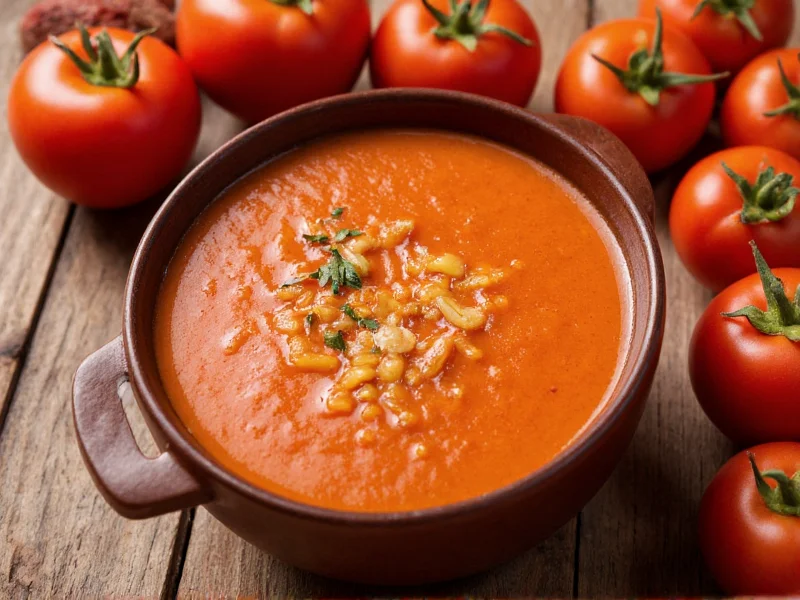Why Fresh Tomatoes Transform Your Soup
While canned tomatoes provide convenience, homemade tomato soup with fresh tomatoes delivers superior flavor complexity and brightness. Fresh tomatoes contain natural acids and sugars that develop beautifully when cooked slowly. The peak season for tomatoes (June-September in most regions) produces fruit with optimal sugar-to-acid balance, creating a naturally sweet soup without added sugar.
When making fresh tomato soup from scratch, heirloom varieties like Brandywine or Cherokee Purple add distinctive flavor notes compared to standard grocery store tomatoes. Garden-fresh tomatoes contain higher levels of lycopene and vitamin C than their store-bought counterparts, especially when vine-ripened.
Selecting the Perfect Tomatoes
Not all tomatoes work equally well for soup. For the best tomato soup recipe with fresh tomatoes, choose:
| Tomato Type | Best For Soup? | Flavor Profile |
|---|---|---|
| Roma/Plum | Excellent | Meaty, less watery, ideal base |
| Beefsteak | Good | Balanced sweetness, some seeds |
| Cherry | Fair | Sweet but time-consuming to process |
| Green Tomatoes | Poor | Too acidic for standalone soup |
Select tomatoes that feel heavy for their size with smooth, unblemished skin. Avoid refrigeration, which damages texture and flavor. For how to make tomato soup with garden tomatoes, use tomatoes at room temperature for optimal flavor release during cooking.
Essential Equipment
You don't need specialized equipment for easy fresh tomato soup without cream. Essential tools include:
- Large heavy-bottomed pot (prevents scorching)
- Blender or immersion blender (for smooth texture)
- Sharp knife and cutting board
- Bowl of ice water (for tomato blanching)
- Fine mesh strainer (optional for seed removal)
Step-by-Step Fresh Tomato Soup Recipe
This summer tomato soup recipe serves 4 and takes 50 minutes total:
- Prepare tomatoes: Score an "X" on the bottom of each tomato. Blanch in boiling water for 30 seconds, then transfer to ice water. Skins should peel off easily. Remove cores and roughly chop.
- Saute aromatics: Heat 2 tbsp olive oil in a large pot over medium heat. Add 1 diced onion and 2 minced garlic cloves. Cook until translucent (5-7 minutes).
- Add tomatoes: Stir in 2 lbs prepared tomatoes, 2 cups vegetable broth, 1 tsp sugar (optional), salt, and pepper. Bring to a gentle simmer.
- Simmer: Cook uncovered for 30-40 minutes, stirring occasionally, until tomatoes break down completely and liquid reduces slightly.
- Blend: Remove from heat. Using an immersion blender or regular blender (in batches), puree until smooth. For ultra-smooth texture, strain through a fine mesh sieve.
- Finish: Return to low heat. Stir in 1/4 cup fresh basil. Adjust seasoning. Serve immediately.
Avoiding Common Fresh Tomato Soup Mistakes
Many home cooks encounter issues with fresh tomato soup cooking time and texture. Prevent these problems:
- Watery soup: Simmer long enough to reduce liquid. Fresh tomatoes contain more water than canned. Proper reduction takes 30-40 minutes.
- Bitter flavor: Remove tomato cores completely. The core area contains bitter compounds. Avoid overcooking basil, which turns bitter.
- Seedy texture: For silky texture, strain soup after blending. This step is especially important with seedy varieties like beefsteak.
- Flat flavor: Balance acidity with a pinch of sugar or a Parmesan rind during cooking. Don't skip the salt step - it enhances natural tomato flavor.
Serving and Storage Tips
For the best experience with your heirloom tomato soup recipe:
- Serve hot with a drizzle of good olive oil and fresh basil
- Pair with crusty bread or grilled cheese sandwiches
- Store in airtight container in refrigerator for up to 4 days
- Freeze in portion-sized containers for up to 3 months
- Reheat gently over medium-low heat to preserve fresh flavor
Delicious Variations
Customize your fresh tomato soup recipe from scratch with these options:
- Creamy version: Stir in 1/2 cup heavy cream or coconut milk at the end (not traditional but popular)
- Roasted tomato variation: Roast tomatoes at 400°F for 30 minutes before adding to pot for deeper flavor
- Spicy kick: Add red pepper flakes or a dash of hot sauce during cooking
- Herb variations: Substitute oregano or thyme for basil, or use a combination
- Vegan option: Ensure broth is vegan and skip any dairy additions
Why This Method Works Best
The key to exceptional how to make tomato soup with fresh tomatoes lies in technique rather than complexity. Blanching removes skins that can become tough during cooking. Simmering without a lid allows excess water to evaporate, concentrating flavor. Adding fresh herbs at the end preserves their bright flavor compounds that would dissipate with prolonged cooking.
Unlike canned tomato soup recipes, this fresh approach captures the essence of summer tomatoes at their peak. The natural sweetness develops through proper reduction rather than added sugar. This method respects the integrity of the main ingredient while enhancing its natural qualities through time-tested culinary techniques.











 浙公网安备
33010002000092号
浙公网安备
33010002000092号 浙B2-20120091-4
浙B2-20120091-4